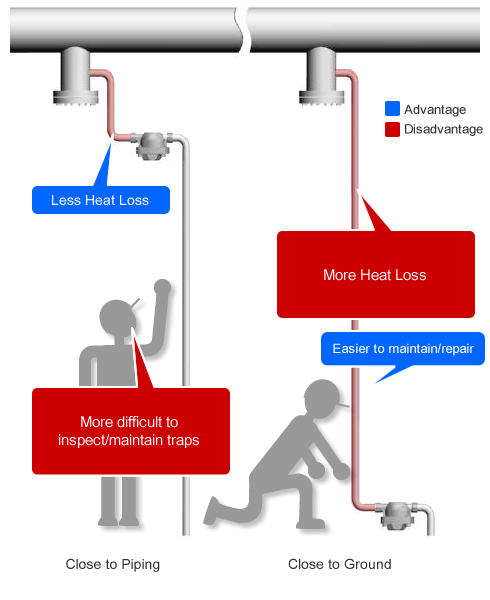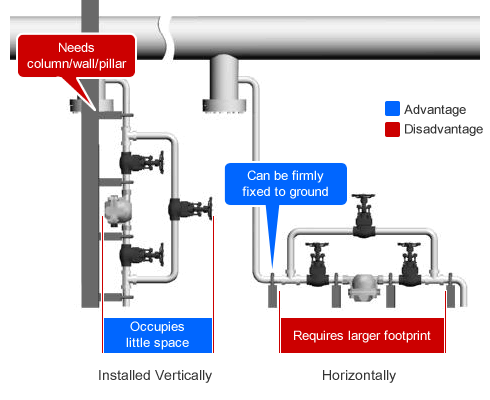- Home
- Steam Resources
- Steam Theory
- Installation Tips for Steam Traps on Steam Mains
Steam Distribution
Installation Tips for Steam Traps on Steam Mains
Following the article Best Practices for Condensate Removal on Steam Lines, this article aims to offer tips on where to install steam traps on steam mains and steam branch lines.
Trap Location: Close to Piping or Ground?
Have you ever wondered about the best location to install a steam trap on a steam main?
Since the inlet side of a trap is simply an extension of the steam main, one method has been to install the trap close to the main line to limit heat loss from radiation.
However, since steam mains are often set in elevated locations, one major disadvantage of setting a steam trap close to the main is that it can make it much more difficult to inspect and maintain the trap. Traps that are not easily accessible also risk being neglected or forgotten, which can lead to problems if the trap is not operating properly. Often, such traps in inaccessible locations can fail and be left unnoticed for many years.
If a ladder or some other means of access is permanently set in place, then even traps set in elevated locations can easily be inspected and maintained. If such a setup isn't feasible, then setting the trap in an easily accessible location is recommended, with the requirement that any horizontally-installed trap should be located as close to the vertical drop leg as possible. The trap inlet piping should then be well insulated to limit heat loss.
| Setting Trap Close to Piping vs. Close to Ground |
|---|
|
|
| Advantage | Disadvantage | |
|---|---|---|
| Close to Piping | Less heat is lost through radiation | More difficult to inspect and maintain traps, which might lead to circumstances where a failed trap is simply forgotten. |
| Close to Ground | Easier to maintain and repair | More heat loss through radiation because the longer downpipe acts as a smaller bore extension of the steam line. (Insulation can help reduce heat loss significantly in cases where trap operation is not negatively affected by insulation.) |
Additional Note
When installing a steam trap on a steam main, TLV typically recommends the use of traps that discharge condensate continuously, such as the Free Float® type. Other trap types such as disc, bucket, or balanced pressure thermostatic can be used provided that the collecting leg is adequately sized to prevent back-up into the steam main. Bimetal traps are not recommended for use on steam mains due to the possibility of large back-up distances which could pool condensate in the steam main itself. This is an especially worrisome situation when the trap is located close to the steam main.
Trap Orientation: Vertical or Horizontal?
When draining condensate from an elevated steam main using a drip leg, if space is of concern, it is possible to install the trap directly on the vertical section of the trap inlet piping to save space. While the horizontal and vertical setups require virtually the same components, such as a bypass valve with manual valves set before and after the trap, setting the trap at ground level means that greater space is required to install all these components horizontally.
On the other hand, setting the trap on the vertical section of the trap inlet piping does require proper vertical support such as a pipe rack column or pillar for the trap and other piping. Also, if the trap is not firmly set on the ground, maintenance and repairs can also become more difficult to accomplish, so some method for anchoring to the ground or vertical support is still required.
Support is usually not a problem when setting the trap and piping closer to the ground, as the ground can provide support for the installation. Repairs and maintenance are also easier to accomplish because components are typically more easily accessible.
As each method has its pros and cons, it's important choose the most suitable setup for your particular location.
| Setting Trap Vertically vs. Horizontally |
|---|
|
|
| Advantage | Disadvantage | |
|---|---|---|
| Installed Vertically | Occupies little space. | Needs installation against a column/wall/pillar. Its position can make maintenance tasks more difficult. |
| Installed Horizontally | Can be firmly fixed to the floor/ground. | Requires a larger footprint added space. |
Additional Note
Furthermore, when selecting traps such as the Free Float® type for steam mains, it is important to realize that different models exist for horizontal and vertical piping installations.
Summary
Installing a trap off a steam main isn't simply about trap selection. There are a number of other factors involved such as proximity to the steam main and space requirements. It is highly recommended to evaluate trap location and setup before purchasing traps to ensure the safe and efficient transport of steam to the location where it is needed. Proper setups should try to minimize steam loss while allowing for easy maintenance.
All these factors should be taken into account when deciding the trap setup that will provide the greatest benefits over the long term.




